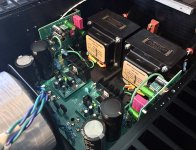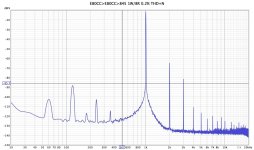Two positive regulator’s outputs can be connected from one’s ground to another’s positive rail to provide symmetrical +- supply. Rectifier parts must use two separate transformer windings and separate grounds.hopefully Tombo can comment if he sees this.
Not really, but my first build I am doing now will be using the prasi pcb with the active bridge. There is a bit more room on Cody's pcb though, and the R21 is easier to mount.
thanks for the temp guidance Tombo. Glad to know I’m not in dangerous territory.
Regarding the start-up sequence, the first four or so seconds have mild noise on the speakers, then it drops to silence. It appears to take the regs a few moments to reach the prescribed voltage drop, and I’ll see a few intermittent red flashes until they’ve climbed to .7v or so. Entire sequence last 10 seconds. All sound normal? The amp is a single-ended class A SIT OPT-coupled amp dissipating 100W or so per channel.
Regarding the start-up sequence, the first four or so seconds have mild noise on the speakers, then it drops to silence. It appears to take the regs a few moments to reach the prescribed voltage drop, and I’ll see a few intermittent red flashes until they’ve climbed to .7v or so. Entire sequence last 10 seconds. All sound normal? The amp is a single-ended class A SIT OPT-coupled amp dissipating 100W or so per channel.
Double-check that it fits comfortably in your chassis. I made it to keep wire runs short to the amp boards, but it could be too wide for some chassis.Not really, but my first build I am doing now will be using the prasi pcb with the active bridge. There is a bit more room on Cody's pcb though, and the R21 is easier to mount.
Everything behaves as it should. It is explained in the circuit description. First 3.5 second or so, regulators behave as a piece of wire. That enables them to tolerate and provide start-up current for filling up any large (up to extreme) capacitors at output, without burning. What you hear at that first seconds, is just unregulated power supply.Regarding the start-up sequence, the first four or so seconds have mild noise on the speakers, then it drops to silence.
Red LED flashing is indication that during that final supply voltages settling for a moment, input voltage (at first capacitor) drops below set output voltage. It’s harmless but you could set voltage drop a fraction up to 1 -1.2 V.
Sounds good, thanks Tombo. It’s actually a great demonstration for this reg, as we get to hear a glimpse of the ‘before’ and then the total silence of ‘after’. Great work!
Finally wrapped up my amp project using the R21 motherboard. Its a 77B OPT-coupled common source amp – a Singing Bush style jfet buffer (thanks ZM) in front of a CS wired SIT and no feedback employed. Nothing new regarding the circuit itself, but its worth noting that the circuit has pretty poor PSRR. Still have a few more measurements to try, but the attached THD measurement hints at the quality of the R21 in action. Looking specifically at the 60hz harmonics, I can say with some certainty that these are due to magnetic coupling and the overall tight quarters of my initial test chassis. Even with those limitations, I'm impressed by the lack of noise. For comparison, see the attached image of an 845 SE amp that I built which uses a CLC filtering solution. Having built this proof of concept, I'm thinking that these channels ultimately deserve to be split-up and put in proper monoblock configuration.
Attachments
You are right. It’s very hard to avoid some magnetic coupling, either directly to amplifier input or to measurement gear. There is only about 15 uV level at 120 Hz at your distortion measurement. Considering ripple before regulators, they pass only 1 uV ripple to their output or to amplifier rails. Rest is caused by induced noise. Peak at 60 Hz is directly induced from mains transformer and strong rectified current peaks, charging capacitors, cause 120 Hz radiated noise (+ some harmonics) that end in amplifier and measurement gear.
Still, incomparably better results than with an ordinary supply. 🙂
Still, incomparably better results than with an ordinary supply. 🙂
Yes, so much better than with an ordinary supply. This is not a great project to show the real possibilities of the R21, but it still shows how it turn a noisy circuit into something special. Can't imagine how this would perform with a complimentary circuit that already has some good cancellation. Super impressed with the impact it had on my project!
Seeing codyt involved in this made me think I needed to take a look. And this is interesting.
I am using a THF51 amplifier/buffer - ra7's MOFO variation. This amplifier can be used with either a plus or negative supply.
At the moment I am using negative voltage so my goofy question: which of the two is the better regulator?
Would you recommend using one over the other when one has a choice?
This is something that needs to be tried, at the least.
Thanks for you work and generosity, tombo.
I am using a THF51 amplifier/buffer - ra7's MOFO variation. This amplifier can be used with either a plus or negative supply.
At the moment I am using negative voltage so my goofy question: which of the two is the better regulator?
Would you recommend using one over the other when one has a choice?
This is something that needs to be tried, at the least.
Thanks for you work and generosity, tombo.
Once you are below audible noise floor at any listening conditions, it can get better only by measurements, not by sound. You have terrific ‘tube amplifier’ without any glass & vacuum involved.Can't imagine how this would perform with a complimentary circuit that already has some good cancellation
Regulators work in several amplifiers builds that have very good PSRR. That combination results with ultimate clean low noise output where mains artifacts are at below single uV. That is just nice bragging number unnecessary for excellent sound. Here is a wide band measurement of my amplifier output.
It is a justified question. With rare exceptions (Jung-Didden super regulators, Salas’ shunt and some other) we don’t know what is real performance of various regulated supplies, published here or elsewhere. Simulation results are mostly pipe dreams.At the moment I am using negative voltage so my goofy question: which of the two is the better regulator?
Both R21 modules perform practically the same in all important parameters: regulation, noise, PSRR, output impedance, transient response and rails modulation by AC load (from amplifier). They were designed for use in symmetrical supply for push-pull amplifiers. So, equal performance was design goal from the beginning and I believe that design goal was met.
On the funny note, if anyone wonders why R21 name? In my initial naive enthusiasm, I envisioned a ‘42’ solution. Reality has made me to get only half way to the dreamed solution, so 21. Coincidentally, I was near 21st small design revision. 🤣
Any news about this version?There will be integrated single rail supply with active rectifier in the future. No over voltage but soft ramp-up. PSRR should be good up to 100 MHz range. It’ll require some time to finish design, build prototype and perform testing. Current state, several days in project:
View attachment 1366874
I had wondered why you called it R21 - I thought maybe it corresponded with the designation of a resistor in a CRC network of a beloved amplifier.
I think I will proceed with the negative version.
I found no important parts unavailable - I think a specified resistor was not available. Plenty of others to choose from.
I had never ordered from the ubiquitous China based PCB manufacturer and once I figured out you had to "open" an account first - that was easy.
I could not resist - I had to get 2mm thick and 2 ounces copper - why not? Ordered 10 so I will have six extra IF I do not screw one of them up.
Can't wait to hear what this does.
Thanks, again, tombo
I think I will proceed with the negative version.
I found no important parts unavailable - I think a specified resistor was not available. Plenty of others to choose from.
I had never ordered from the ubiquitous China based PCB manufacturer and once I figured out you had to "open" an account first - that was easy.
I could not resist - I had to get 2mm thick and 2 ounces copper - why not? Ordered 10 so I will have six extra IF I do not screw one of them up.
Can't wait to hear what this does.
Thanks, again, tombo
Got my boards from JCLPCB.
Never have ordered from them and it was very easy and confidence inspiring. Very well run business.
Now to get the parts in.
Replacing the HAMMOND 5 amp 100 mH chokes will open up lots of room!
The output capacitor can now be placed close to the THF51.
Never have ordered from them and it was very easy and confidence inspiring. Very well run business.
Now to get the parts in.
Replacing the HAMMOND 5 amp 100 mH chokes will open up lots of room!
The output capacitor can now be placed close to the THF51.
- Home
- Amplifiers
- Power Supplies
- An arguably better replacement for the resistor in a CRC power supply - R21 PS module


